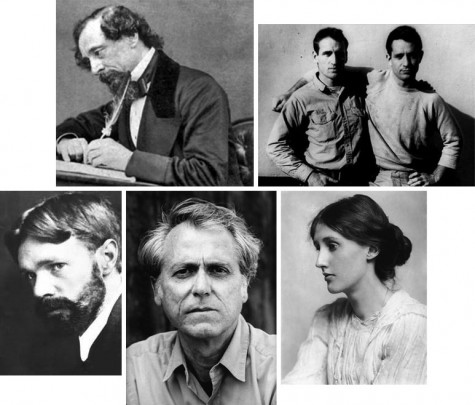
If you’re looking for reading suggestions in bulk, you’re spoiled for choice. There are classics, like Clifton Fadiman’s Lifetime Reading Plan or Harold Bloom’s The Western Canon
. And in recent years, a cottage industry has sprung up of books that recommend books — The Top Ten
, Book Lust
(and its follow-up, More Book Lust
), The Modern Library
, etc., etc.
Some of these efforts are quite good and owned by the authors of this feature — but a problem arises: Such guides are presumably meant to save readers time by pointing them in the right direction, but the guides themselves amount to several months or years of reading. The books they recommend add up to several lifetimes. What starts as an attempt to save hours ends as a commitment to more hours than you probably have.
That’s where we come in. Below is a list of ten books that will be pressed into your hands by ardent fans. Resist these people. Life may not be too short (I’m only in my mid-30s, and already pretty bored), but it’s not endless.
(When you’re done reading, please go here to second these feelings or call us crazy, and to share your own suggestions.)
White Noise by Don DeLillo
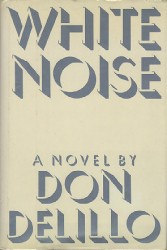 White Noise won the National Book Award in 1985. It’s widely beloved and stars Jack Gladney, a professor who invents the department of Hitler Studies. The novel also features a vague “Airborne Toxic Event,” and like much of DeLillo’s work, it’s been praised for its dark humor and its prescience about social disasters and paranoia.
White Noise won the National Book Award in 1985. It’s widely beloved and stars Jack Gladney, a professor who invents the department of Hitler Studies. The novel also features a vague “Airborne Toxic Event,” and like much of DeLillo’s work, it’s been praised for its dark humor and its prescience about social disasters and paranoia.
There are three major problems with it: 1) DeLillo’s condescension to his characters is jaw-dropping. He is the wised-up, courageous seer, and they are blind idiots representing everything that’s shallow and cowardly about American culture. Needless to say, this authorial voice is maddening. 2) Its sense of dread is conveyed with what the critic B.R. Myers, discussing another of DeLillo’s novels, called “the safe, catchall vagueness of astrologists and palm readers.” To wit: “Why do these possessions carry such sorrowful weight? There is a darkness attached to them, a foreboding. They make me wary not of personal failure and defeat but of something more general, something large in scope and content.” 3) The book strains to be funny, and some readers actually claim it is, but there isn’t a single laugh to be had. The paranoid, judgmental DeLillo trying to be funny is like Jim Carrey trying to be somber — it’s all about the trying, and the effort is the only thing that shows.
DeLillo’s critique of society has all the depth and insight of the average teenager’s, and sometimes less. Early in the novel, Gladney surveys students arriving on campus, and apparently this laundry list passes for incisive:
. . . the junk food still in shopping bags — onion-and-garlic chips, nacho thins, peanut creme patties, Waffelos and Kabooms, fruit chews and toffee popcorn; the Dum-Dum pops, the Mystic mints.
As in almost every scene in the novel, DeLillo sacrifices any sense of realism for dull, thin polemic. To critique the image on just one level, this is a completely unlikely haul of groceries for any one person. They can be believable characters, or they can buy bags and bags full of things called Waffelos, Kabooms and Dum-Dum pops. In his strong desire to make his characters ridiculous and contemptuous, DeLillo opts for the candy.
*****
Absalom, Absalom by William Faulkner
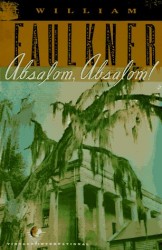 For someone who adores Faulkner’s The Sound and The Fury, thinks it a nearly perfect work and possibly the greatest American novel of the 20th century, it is particularly difficult to urge the passability of one of his other “big” books. But Faulkner wrote at his best in the first person, when he was inhabiting and growing with a consciousness, following it to its bloody, myth-driven destiny. Detached descriptions of others’ thoughts and actions, and the scenery they moved through, was not his territory. Much of Absalom, Absalom is full of festering bushels of dud coinages, Biblical bluster, and diarrheal sentences that do nothing but draw attention to their over-toasted ornamentation. (See, after re-reading only a page of it, look what I sound like.)
For someone who adores Faulkner’s The Sound and The Fury, thinks it a nearly perfect work and possibly the greatest American novel of the 20th century, it is particularly difficult to urge the passability of one of his other “big” books. But Faulkner wrote at his best in the first person, when he was inhabiting and growing with a consciousness, following it to its bloody, myth-driven destiny. Detached descriptions of others’ thoughts and actions, and the scenery they moved through, was not his territory. Much of Absalom, Absalom is full of festering bushels of dud coinages, Biblical bluster, and diarrheal sentences that do nothing but draw attention to their over-toasted ornamentation. (See, after re-reading only a page of it, look what I sound like.)
The novel tells the story of Thomas Sutpen, a Virginian who comes to Mississippi in the nineteenth century with a French architect and an army of slaves to build the plantation known as Sutpen’s Hundred, a principal venue of Faulkner’s fabled Yoknapatawpha County. Sutpen had sired a son (Charles Bon) by a black woman many years before beginning his “legitimate” family, in which he fathered Henry and his sister Judith. Henry meets and befriends Charles at Ole Miss and brings him home. Charles falls in love with Judith. Sutpen realizes this half-brother/sister liaison would result in multiple hells breaking loose, and they do, with different perspectives on the same story being told over and over and (yes) over.
A representative paragraph:
Out of quiet thunderclap he would abrupt (man-horse-demon) upon a scene peaceful and decorous as a schoolprize water color, faint sulphur-reek still in hair clothes and beard, with grouped behind him his band of wild negroes like beasts half tamed to walk upright like men, in attitudes wild and reposed, and manacled among them the French architect with his air grim, haggard, and tatter-ran. Immobile, bearded, and hand palm-uplifted the horseman sat; behind him the wild blacks and the architect huddled quietly, carrying in bloodless paradox the axes and picks and shovels of peaceful conquest. Then in the long unmaze Quentin seemed to watch them overrun suddenly the hundred square miles of tranquil and astonished earth and drag grounds and formal gardens violently out of the silent Nothing and clap them down like cards upon a table beneath the up-palm immobile and prolific, creating Sutpen’s Hundred like the oldentime Be light.
I mean, all readers have to swim through a little tar now and then, but goddamn.
*****
One Hundred Years of Solitude by Gabriel García Márquez
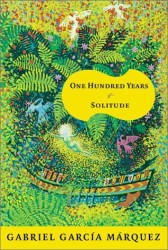 When reading great and famous books, I swore I would never simply say, “I like this” or “I don’t like this” and think that constituted an adequate response to a work of art. Who cares if you don’t like – for example – Middlemarch? It was here before you arrived and it’ll be here long after you’ve gone. A lot of people who know about these things consider Middlemarch to be a masterpiece. So shut up and learn, right?
When reading great and famous books, I swore I would never simply say, “I like this” or “I don’t like this” and think that constituted an adequate response to a work of art. Who cares if you don’t like – for example – Middlemarch? It was here before you arrived and it’ll be here long after you’ve gone. A lot of people who know about these things consider Middlemarch to be a masterpiece. So shut up and learn, right?
Well, the temptation to say – no, yell – “I don’t like One Hundred Years of Solitude!!” is mighty strong.
I can’t decide whether I was bored when I picked up García Márquez or whether García Márquez bored me. Either way, it was the wrong moment to dig into a long, winding, mono-paced magical realist yarn. The book snakes and winds and digresses in a way that seemed rather lifeless to me. For all the deaths and births, affairs, marriages, storms and wars, it was only words on paper (a fact unhelpfully underlined by García Márquez in the textual ending of the novel). It only took me eight days or so to read it but it felt much longer. I kept looking in vain for the book’s inherent Nobel-ish qualities. And I kept looking at my watch.
Magical realism wasn’t much of a trick to begin with – Gabriel García Márquez riding round in circles on a smallish tricycle, cigarillo clamped between teeth, occasionally raising his panama for people to throw coins – and is now thoroughly clapped out. Also, people who like it seem to have little or no sense of humor. No one knows why, but it’s true. Instead it inspires a sort of insufferably pious stupefaction. Perhaps if you were to read Solitude, you too would be borne aloft on its miraculous wings, transported by its spellbinding portrait of a world which is part exotic paradise, part nightmare, etc., etc., etc., but I wouldn’t risk it.
*****
The Road by Cormac McCarthy
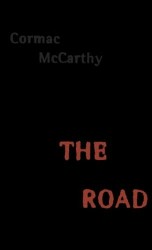 I’m a longtime fan of McCarthy’s, but his stark-and-somehow-simultaneously-baroque tone, which occasionally threatens to send even his best work off the rails, is a fatal flaw here. McCarthy benefits greatly from specificity of character and complexity of plot, which distinguished the first two volumes in his Border Trilogy. John Grady Cole (All the Pretty Horses) and Billy Parham (The Crossing) tethered McCarthy to more conventional journeys, taken by young men who easily inspired emotional investment. The more faceless his characters — and the more generic their march through nature’s indifference, human violence and despair — the more his writing verges on a parody of itself. In setting The Road in a post-apocalyptic world where plot is beside the point and the two main characters are — given their hazily remembered past, monochrome present, and probable lack of a future — inevitably archetypal, McCarthy booby-traps himself. He’s a writer who could make a casual brunch read like the end of the world, so when he’s actually writing about the end of the world, his grandiosity grows numbing. In this sense, his language fails The Road, distracting from the emotional potency it might have had. The dialogue between father and son echoes the affected rhythms of the conversations between cowboys in the Border Trilogy. One sample from The Road:
I’m a longtime fan of McCarthy’s, but his stark-and-somehow-simultaneously-baroque tone, which occasionally threatens to send even his best work off the rails, is a fatal flaw here. McCarthy benefits greatly from specificity of character and complexity of plot, which distinguished the first two volumes in his Border Trilogy. John Grady Cole (All the Pretty Horses) and Billy Parham (The Crossing) tethered McCarthy to more conventional journeys, taken by young men who easily inspired emotional investment. The more faceless his characters — and the more generic their march through nature’s indifference, human violence and despair — the more his writing verges on a parody of itself. In setting The Road in a post-apocalyptic world where plot is beside the point and the two main characters are — given their hazily remembered past, monochrome present, and probable lack of a future — inevitably archetypal, McCarthy booby-traps himself. He’s a writer who could make a casual brunch read like the end of the world, so when he’s actually writing about the end of the world, his grandiosity grows numbing. In this sense, his language fails The Road, distracting from the emotional potency it might have had. The dialogue between father and son echoes the affected rhythms of the conversations between cowboys in the Border Trilogy. One sample from The Road:
We have to stop, he said.
It’s really cold.
I know.
Where are we?
Where are we?
Yes.
I dont know.
I understand that this is the apocalypse, and that end times probably won’t lend themselves to chattiness, but still, these terse, stoic exchanges between father and child rang false to me. It didn’t help that when they weren’t talking, they weren’t doing much of anything:
They slept through the night in their exhaustion and in the morning the fire was dead and black on the ground. He pulled on his muddy shoes and went to gather wood, blowing on his cupped hands. So cold. It could be November. It could be later. He got a fire going and walked out to the edge of the woodlot and stood looking over the countryside. The dead fields. A barn in the distance.
Without many other characters and without any discernible variety in the charred landscape, that scene is all too representative of the book’s progress. In fact, my enduring memory of The Road will be that paragraph stuck on repeat. It’s a fine paragraph. But 241 pages of it is overkill.
*****
The Rainbow by D. H. Lawrence
 The Rainbow was published in 1915, and six weeks later, having been the subject of a trial for indecency, it was withdrawn from publication, the remaining copies rounded up and burned. Tragically, though, the manuscript and printing plates survived (the editor, likewise, was remarkably and perhaps unjustly unscathed) and the interminable saga of the Brangwen family would live on to torment generations of literary kids looking for an honest cheap thrill.
The Rainbow was published in 1915, and six weeks later, having been the subject of a trial for indecency, it was withdrawn from publication, the remaining copies rounded up and burned. Tragically, though, the manuscript and printing plates survived (the editor, likewise, was remarkably and perhaps unjustly unscathed) and the interminable saga of the Brangwen family would live on to torment generations of literary kids looking for an honest cheap thrill.
The book was yanked for ostensibly racy sex, but you won’t find much of that here. Instead, much of what it contains — redundant, stultifyingly interior, almost eventless — is reminiscent of nothing so much as the things an English prof endures on the way to getting into a sensitive student’s pants: the gushing, the journal reading, the unedited first drafts. Viz:
She could be very happy. And she wanted to be happy. She resented it when he made her unhappy. Then she could kill him, cast him out. Many days, she waited for the hour when he would be gone to work. Then the flow of her life, which he seemed to dam up, was let loose, and she was free. She was free, she was full of delight. Everything delighted her.
This barn-burner comes amid a long section on the early marital squabbles of young Will and Anna Brangwen, 40 pages in which the two struggle and storm within themselves and almost nothing actually happens. In the rest of the book, which spans some 65 years, other characters make their way onstage to storm and struggle and do next to nothing. Generations come and go, wishing, along with the reader, that something would happen:
The season had been rainy and dreary. In the evening it was pouring with rain. Fred Brangwen, unsettled, uneasy, did not go out, as was his wont. He smoked and read and fidgeted, hearing always the trickling of water outside. [Note to reader: It’s raining.] This wet, black night seemed to cut him off and make him unsettled, aware of himself, aware that he wanted something else, aware that he was scarcely living.
We, too, want something else. We are aware that our characters are scarcely living. We are aware we’d like to read another book. Or maybe fix a sandwich and see who’s on Conan. At the end of The Rainbow (if anyone has ever reached such a place), there’s a wonderful treasure: the freedom to go on to another, less frustrating book.
*****
On the Road by Jack Kerouac
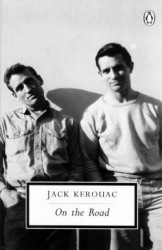 Like many nerds of the ’80s and ’90s, I read On the Road, that classic of identity literature, in high school. I read it as a textbook on how to be cool. And like many of the traditional textbooks I read at the time, it filled me with awe and boredom. I assumed there was knowledge to be gained therein, but the style was mystifying and uncomfortable. I sensed that an ideology was being foisted on me, and my mind began to rebel. Still, I slogged through until the last line, repulsed by the sloppiness, the sexism, the sappiness. Reading On the Road would not get me into a good school; nor would it get me into the school of life. Because cool people didn’t read On the Road. They flipped through it while they were waiting for their friends to pick them up to drive to Burning Man, or to the organic Moog farm in Detroit, or to other cool-people activities.
Like many nerds of the ’80s and ’90s, I read On the Road, that classic of identity literature, in high school. I read it as a textbook on how to be cool. And like many of the traditional textbooks I read at the time, it filled me with awe and boredom. I assumed there was knowledge to be gained therein, but the style was mystifying and uncomfortable. I sensed that an ideology was being foisted on me, and my mind began to rebel. Still, I slogged through until the last line, repulsed by the sloppiness, the sexism, the sappiness. Reading On the Road would not get me into a good school; nor would it get me into the school of life. Because cool people didn’t read On the Road. They flipped through it while they were waiting for their friends to pick them up to drive to Burning Man, or to the organic Moog farm in Detroit, or to other cool-people activities.
Allen Ginsberg and Jack Kerouac were the first true nerds who, during a brief window of time, became truly cool. Ginsberg was a physical and intellectual nerd, and Kerouac was an emotional nerd — combined, their forces created a hole in the identity universe into which the distinction between nerd and cool person was exploded into dark matter. In midcentury, all who fell into this roiling cosmic trap became permanently scrambled, identitywise. This galactic disturbance allowed neoliberalism to firmly take hold, such that now the only relevant distinctions between people are levels of disposable income and whether they wear Bluetooth earpieces. Reading as an effective form of vision quest was destroyed forever. Teens today don’t bathe in dust motes in their bedrooms wondering who they are or if they’re worthy. So if you’re getting older and still haven’t read On the Road, don’t bother. The cool people say Dharma Bums is better anyway. If you’re still curious, you should call up the YouTube clips of Kerouac ostensibly reading from a copy of On the Road on Steve Allen’s show, because he’s less embarrassing in person than his words are on the page. Or you can read the original scroll released by Viking in 2007 in parallel with the original published version, in this way learning what it means to be an editor. The third option is to pick up a copy of Goethe’s Elective Affinities, another brain-freezingly sentimental look at free love with a spit-take ending, but one in which the characters bring on their altered states by staring at tableaux vivants and magnets.
*****
The Corrections by Jonathan Franzen
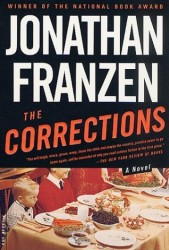 In 1996, Franzen wrote a piece for Harper’s called “Perchance to Dream,” in which he bemoaned the state of serious reading and chronicled his “despair about the possibility of connecting the personal and the social” in today’s novels. The essay received a good deal of attention and set expectations for his next book, which would appear five years later, pretty high. The Corrections was published in mid-September 2001, when the world was preoccupied. But the anticipation in literary circles, and the “controversy” surrounding Franzen’s rejection of Oprah Winfrey’s benediction, helped propel robust sales, and the novel won the National Book Award.
In 1996, Franzen wrote a piece for Harper’s called “Perchance to Dream,” in which he bemoaned the state of serious reading and chronicled his “despair about the possibility of connecting the personal and the social” in today’s novels. The essay received a good deal of attention and set expectations for his next book, which would appear five years later, pretty high. The Corrections was published in mid-September 2001, when the world was preoccupied. But the anticipation in literary circles, and the “controversy” surrounding Franzen’s rejection of Oprah Winfrey’s benediction, helped propel robust sales, and the novel won the National Book Award.
The book concerns the Lambert family, a Midwestern brood whose three children (Chip, Denise and Gary) have relocated to the Northeast. Alfred, their father, is suffering through increased senility, and Enid, their mother, wants the family to gather at the house for one last Christmas together. Franzen breaks the book into sections, each focusing on one of the children in particular, before bringing the Lamberts together for a grand finale. Until that last section, which is moving, the novel’s episodes keep the siblings isolated and floating in space, and draws out the smaller details of their lives (including a fight between Gary and his wife that’s recounted to the point of stultification) in a way that sacrifices a dynamic sense of the family.
The bigger problem is that Franzen strains to connect each of the story’s threads to a Big Social Issue. He is painfully stuck between domestic drama and what James Wood termed “hysterical realism” — two genres that I’m unconvinced can peaceably coexist — and he revealed as much in the aforementioned Harper’s essay, when he wrote of his time producing The Corrections:
After Strong Motion was published, I took a year off to gather material. When I got back to writing fiction I thought my problem might be that I hadn’t gathered enough. But the problem manifested itself as just the opposite: an overload. I was torturing the story, stretching it to accommodate ever more of those things-in-the-world that impinge on the enterprise of fiction writing. The work of transparency and beauty and obliqueness that I wanted to write was getting bloated with issues. I’d already worked in contemporary pharmacology and TV and race and prison life and a dozen other vocabularies; how was I going to satirize Internet boosterism and the Dow Jones as well while leaving room for the complexities of character and locale?
The solution to this would have been to keep the complexities of character and locale, which he occasionally achieves, while ignoring the impulse to satirize every cultural trend and institution that crossed his mind. Franzen does the domestic quite well, but he’s clumsy when it comes to the larger social canvas. When siblings spar (as in a series of funny e-mails between Chip and Denise), or when parents deal with the pains of aging, The Corrections is as vital as Franzen so desperately intended it to be. But there are several hysterical strands that trip him up, including a ridiculous subplot in which one brother becomes involved in a scheme to promote Lithuania on the web.
*****
The USA Trilogy by John Dos Passos
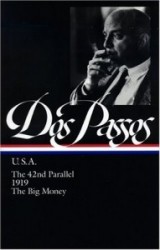 Dos Passos’ project in the USA Trilogy was (I’m told) to recreate the sense of fragmentation in early twentieth-century America. He tackles a variety of admittedly ambitious subjects — immigrants in America, class conflict, the worldwide turmoil caused by the Great War, among others — and in doing so, reveals the shortcomings of the novel as an artistic form.
Dos Passos’ project in the USA Trilogy was (I’m told) to recreate the sense of fragmentation in early twentieth-century America. He tackles a variety of admittedly ambitious subjects — immigrants in America, class conflict, the worldwide turmoil caused by the Great War, among others — and in doing so, reveals the shortcomings of the novel as an artistic form.
In what seems to be an attempt to effect something like a kaleidoscopic documentary film (which obviously wasn’t an option for him), Dos Passos composes the trilogy’s novels using prose accounts of various characters (real and fictional), descriptions of newsreels, verse narratives and imagistic segments titled “The Camera Eye.” There are even line drawings. But as worthy as the project might seem in theory, all this just doesn’t work on the page. For one thing, in this business of artistic fragmentation, this selective elision, he just leaves us frustrated. He comes across like that annoying colleague who’s deliberately obscure, baiting you to ask what he’s hiding. Consider this sequence, from Newsreel V in The 42nd Parallel (the first book of the trilogy):
BUGS DRIVE OUT BIOLOGIST
elopers bind and gag; is released by dog
EMPEROR NICHOLAS II FACING REVOLT OF EMPIRE GRANTS SUBJECTS LIBERTY
paralysis stops surgeon’s knife by the stroke of a pen the last absolute monarchy of Europe passes into history miner of Death Valley and freak advertiser of Santa Fe Road may die sent to bridewell for stealing plaster angel
On the banks of the Wabash far away.
This is the sort of thing bad writers, in particular, appreciate because they think it gives them license to do the same. Yes, I get that he’s trying to remove the markers of a cohesive experience, but instead of being drawn in, I’m bumping my head on the glass partition, fiddling with the buttons, trying to clear the static — choose whatever metaphor you prefer for being repelled by the form.
*****
Jacob’s Room by Virginia Woolf
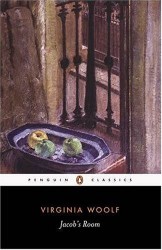 1922! If you’re interested in readin’, it’s a banner year! Birth year of Kurt Vonnegut, Philip Larkin and Kingsley Amis; death year of Proust. In publication terms, too, 1922 was the annus mirabilis: February 2 saw Joyce publish Ulysses; by early fall, T. S. Eliot’s own magazine, The Criterion, had published his poem “The Waste Land” for the first time in the UK (it would appear in the U.S. in November); and on October 26, Virginia Woolf Changed the Course of Literature by doing away with plot, not to mention any real reading enjoyment or insight, when she published Jacob’s Room, a character study of one Jacob Flanders.
1922! If you’re interested in readin’, it’s a banner year! Birth year of Kurt Vonnegut, Philip Larkin and Kingsley Amis; death year of Proust. In publication terms, too, 1922 was the annus mirabilis: February 2 saw Joyce publish Ulysses; by early fall, T. S. Eliot’s own magazine, The Criterion, had published his poem “The Waste Land” for the first time in the UK (it would appear in the U.S. in November); and on October 26, Virginia Woolf Changed the Course of Literature by doing away with plot, not to mention any real reading enjoyment or insight, when she published Jacob’s Room, a character study of one Jacob Flanders.
Flanders is described by everyone else, by mothers and lovers in wilting sad speak, and we watch with a yawn on our lips as he moves from page one, and his boy-who-caught-a-crab-in-a-bucket childhood, to the final page, his victim-of-WWI-empty-shoes-ain’t-it-poignant death. (Flanders — geddit?) His demise is rendered without detail precisely because Woolf never went anywhere near Jacob’s battlefield; what she did instead was utilize the stream-of-consciousness form of writing, whereby the inner thoughts and feelings of a character are splashed onto the page like so much vomit.
Sadly, stream-of-consciousness had been better employed by better writers for years by the time she tried to use it – take a peek, for example, at George Meredith’s greatest work, One of Our Conquerors (1891), and tell me it isn’t all that but better, not to mention more than three decades before Jacob’s Room. In fact, by the turn of the century everyone was at it — witness H.G. Wells’ annoyance at Joyce’s slippery language: Wells thought the first line of the last story of Dubliners (1914), “Lily, the caretaker’s daughter, was literally run off her feet,” displayed nothing more than the love of cliché, too stupid was he to understand that Lily’s language in “The Dead” had insidiously seeped into the narrator’s own. Such an authorial position, mixing first person and third, is a much cleverer, shifting version of stream of consciousness — Woolf’s attempts with it were little more than an easy way to get over the tricky matter of not having lived any of what she was writing. She knew Flanders about as well as we do by the end — it’s what Joni Mitchell would later call “guesses at most” – and as such, it leaves one wishing for a car chase, or a good murder, or a maid like Lily who’s simply got too much to do. We get none of that — instead, at the end, we get a pair of empty shoes.
*****
A Tale of Two Cities by Charles Dickens
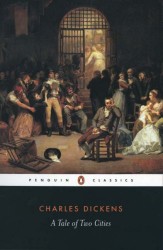 Dickens is at his best anatomizing English mores; the further afield he travels, the worse his writing gets. No country was more foreign to Dickens’ sensibility than France. No event was more antithetical to his imagination than the French Revolution. So it’s unsurprising that A Tale of Two Cities makes for such an odd and uninspiring read.
Dickens is at his best anatomizing English mores; the further afield he travels, the worse his writing gets. No country was more foreign to Dickens’ sensibility than France. No event was more antithetical to his imagination than the French Revolution. So it’s unsurprising that A Tale of Two Cities makes for such an odd and uninspiring read.
It remains one of his most read novels because of its appeal to high school-age students — or rather, to their teachers. Its major themes — loyalty, sacrifice, oppression, class conflict — conform quite neatly with our ingrained sense of what constitutes literature. Literature is not light or meandering, but stern, noble, uplifting, dramatic. Above all, it is serious. Thus the enduring bias that values tragedy above comedy.
Two Cities also possesses one virtue shared by very few of Dickens’ novels: it’s short. At less than 350 pages, it’s one of the only books he wrote that a high schooler can read in less than a month. Unfortunately, its (relative) brevity goes a long way towards explaining its (relative) mediocrity. The nature of Dickens’ genius was to sprawl. He is not an efficient writer, nor should we wish him to be. His imagination needs room to extend itself, to roam down what often turn out to be dead ends (at least where plot is concerned). His great books see him introducing new characters 300 pages into the story; they involve plotlines that go nowhere, characters that do nothing except exist. They are vital, surging, unpredictable things, bursting with the joy of creation. They are also very, very funny. At no point during the reading of Two Cities will you laugh aloud. If it were written by Camus, that might be OK. But it wasn’t, and it’s not.
A Tale of Two Cities would be a good book by another writer, but for Dickens it was a failure. There are plenty of masterpieces of his that you should read: The Pickwick Papers, Great Expectations, the first half of David Copperfield. And when you’re done with those, read Bleak House and Our Mutual Friend. Just don’t convince yourself that you have to get around to A Tale of Two Cities.

